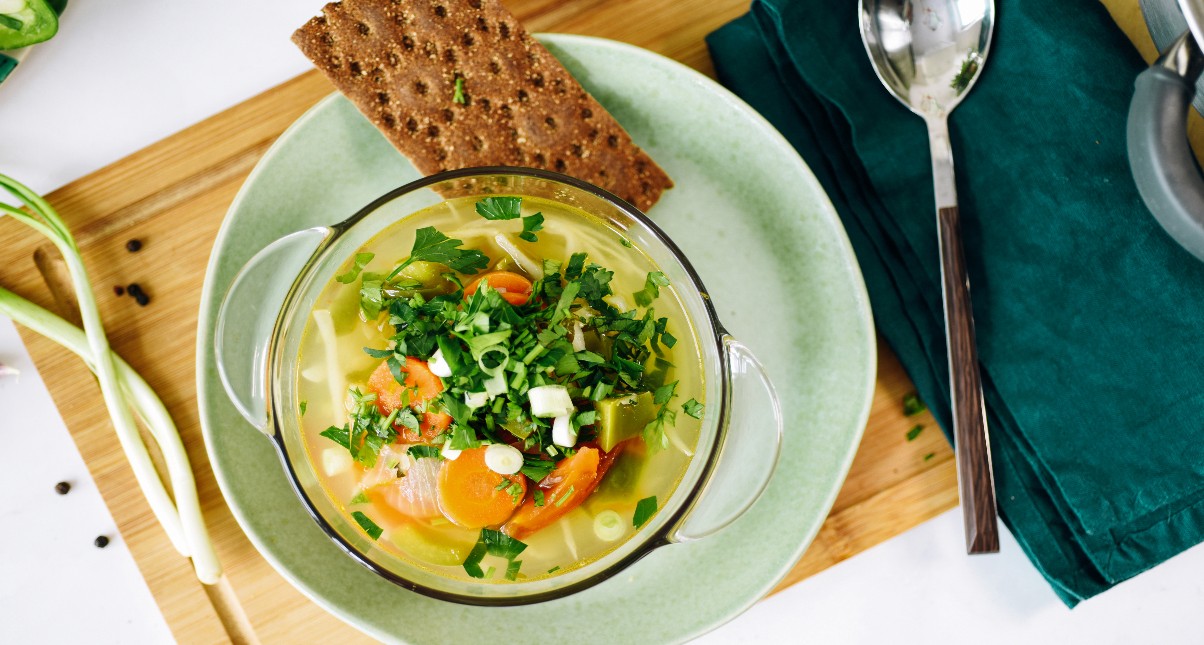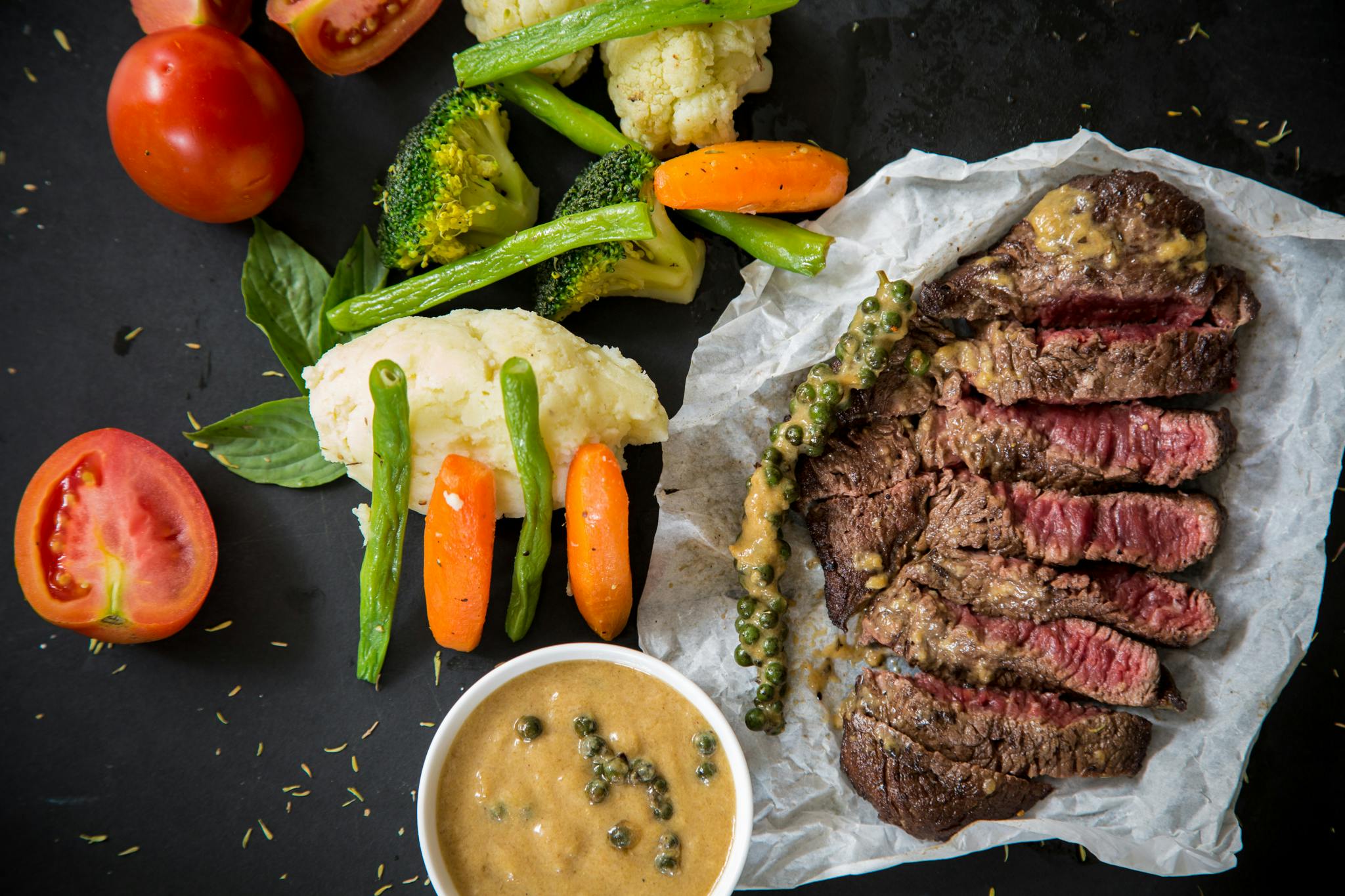Soups often have a reputation for being bland and boring, but the reality is, they’re anything but. Cooked well, soups are nourishing, hearty, and full of flavor - making for a comforting meal-time staple, especially in the colder months.
The best soups are all about the process: allowing various building blocks to come together slowly. So, next time you’re in the kitchen, follow these simple principles for your next bowl to pay off big time.
Make the most of vegetables
Soups are an ideal way to use up vegetable scraps - even sad or wilted vegetables can be transformed into a delicious soup. Consider cook time for each ingredient, and add accordingly. For example, hearty vegetables such as potatoes, squash, carrots, and onions will need more time to cook than more delicate ones like zucchini, tomatoes, or mushrooms. Leafy greens, like spinach or fresh herbs, should be added in the last moments.
Easy does it
Soups are all about layers. Build flavor by browning aromatics (onions, celery, carrots, garlic, or ginger) deeply before adding liquids and other soup components. Start with just a splash of stock (or whatever liquid is being used), to help scrape up all the browned bits stuck to the bottom of the pan. When cooking, simmer gently and avoid allowing the soup to boil, as this can turn the ingredients to mush. A low simmer will meld flavors and ensure everything cooks evenly.
Balance flavors and textures
To avoid a monotone, boring soup, especially if it consists of a single texture, be sure to balance flavors. A splash of acidity, like lemon juice, apple cider vinegar, or a dollop of Greek yogurt will round out a dull soup. For extra punch, try a pinch of chili flakes or extra spices. Want more texture? Garnish smooth soups with toasted nuts, seeds, or whole wheat bread crumbs. The contrast of creamy and crunchy will make for a surprisingly satisfying meal.
Don’t over-salt
Broths, beans, and other added ingredients may have enough salt that will provide enough seasoning overall. When the soup is finished, taste and salt a little bit at a time if needed. Be sure to give it some time to absorb and meld before adding more - this is why soups often taste better the next day or two. If you find that a soup is too salty, a quick trick is to add a whole peeled white potato to the soup and let it simmer for 20-30 minutes. The potato will act as a sponge to the salt. Just be careful not to overcook, or the potato might disintegrate into the soup.
Soups often have a reputation for being bland and boring, but the reality is, they’re anything but. Cooked well, soups are nourishing, hearty, and full of flavor - making for a comforting meal-time staple, especially in the colder months.
The best soups are all about the process: allowing various building blocks to come together slowly. So, next time you’re in the kitchen, follow these simple principles for your next bowl to pay off big time.
Make the most of vegetables
Soups are an ideal way to use up vegetable scraps - even sad or wilted vegetables can be transformed into a delicious soup. Consider cook time for each ingredient, and add accordingly. For example, hearty vegetables such as potatoes, squash, carrots, and onions will need more time to cook than more delicate ones like zucchini, tomatoes, or mushrooms. Leafy greens, like spinach or fresh herbs, should be added in the last moments.
Easy does it
Soups are all about layers. Build flavor by browning aromatics (onions, celery, carrots, garlic, or ginger) deeply before adding liquids and other soup components. Start with just a splash of stock (or whatever liquid is being used), to help scrape up all the browned bits stuck to the bottom of the pan. When cooking, simmer gently and avoid allowing the soup to boil, as this can turn the ingredients to mush. A low simmer will meld flavors and ensure everything cooks evenly.
Balance flavors and textures
To avoid a monotone, boring soup, especially if it consists of a single texture, be sure to balance flavors. A splash of acidity, like lemon juice, apple cider vinegar, or a dollop of Greek yogurt will round out a dull soup. For extra punch, try a pinch of chili flakes or extra spices. Want more texture? Garnish smooth soups with toasted nuts, seeds, or whole wheat bread crumbs. The contrast of creamy and crunchy will make for a surprisingly satisfying meal.
Don’t over-salt
Broths, beans, and other added ingredients may have enough salt that will provide enough seasoning overall. When the soup is finished, taste and salt a little bit at a time if needed. Be sure to give it some time to absorb and meld before adding more - this is why soups often taste better the next day or two. If you find that a soup is too salty, a quick trick is to add a whole peeled white potato to the soup and let it simmer for 20-30 minutes. The potato will act as a sponge to the salt. Just be careful not to overcook, or the potato might disintegrate into the soup.
Soups often have a reputation for being bland and boring, but the reality is, they’re anything but. Cooked well, soups are nourishing, hearty, and full of flavor - making for a comforting meal-time staple, especially in the colder months.
The best soups are all about the process: allowing various building blocks to come together slowly. So, next time you’re in the kitchen, follow these simple principles for your next bowl to pay off big time.
Make the most of vegetables
Soups are an ideal way to use up vegetable scraps - even sad or wilted vegetables can be transformed into a delicious soup. Consider cook time for each ingredient, and add accordingly. For example, hearty vegetables such as potatoes, squash, carrots, and onions will need more time to cook than more delicate ones like zucchini, tomatoes, or mushrooms. Leafy greens, like spinach or fresh herbs, should be added in the last moments.
Easy does it
Soups are all about layers. Build flavor by browning aromatics (onions, celery, carrots, garlic, or ginger) deeply before adding liquids and other soup components. Start with just a splash of stock (or whatever liquid is being used), to help scrape up all the browned bits stuck to the bottom of the pan. When cooking, simmer gently and avoid allowing the soup to boil, as this can turn the ingredients to mush. A low simmer will meld flavors and ensure everything cooks evenly.
Balance flavors and textures
To avoid a monotone, boring soup, especially if it consists of a single texture, be sure to balance flavors. A splash of acidity, like lemon juice, apple cider vinegar, or a dollop of Greek yogurt will round out a dull soup. For extra punch, try a pinch of chili flakes or extra spices. Want more texture? Garnish smooth soups with toasted nuts, seeds, or whole wheat bread crumbs. The contrast of creamy and crunchy will make for a surprisingly satisfying meal.
Don’t over-salt
Broths, beans, and other added ingredients may have enough salt that will provide enough seasoning overall. When the soup is finished, taste and salt a little bit at a time if needed. Be sure to give it some time to absorb and meld before adding more - this is why soups often taste better the next day or two. If you find that a soup is too salty, a quick trick is to add a whole peeled white potato to the soup and let it simmer for 20-30 minutes. The potato will act as a sponge to the salt. Just be careful not to overcook, or the potato might disintegrate into the soup.
Soups often have a reputation for being bland and boring, but the reality is, they’re anything but. Cooked well, soups are nourishing, hearty, and full of flavor - making for a comforting meal-time staple, especially in the colder months.
The best soups are all about the process: allowing various building blocks to come together slowly. So, next time you’re in the kitchen, follow these simple principles for your next bowl to pay off big time.
Make the most of vegetables
Soups are an ideal way to use up vegetable scraps - even sad or wilted vegetables can be transformed into a delicious soup. Consider cook time for each ingredient, and add accordingly. For example, hearty vegetables such as potatoes, squash, carrots, and onions will need more time to cook than more delicate ones like zucchini, tomatoes, or mushrooms. Leafy greens, like spinach or fresh herbs, should be added in the last moments.
Easy does it
Soups are all about layers. Build flavor by browning aromatics (onions, celery, carrots, garlic, or ginger) deeply before adding liquids and other soup components. Start with just a splash of stock (or whatever liquid is being used), to help scrape up all the browned bits stuck to the bottom of the pan. When cooking, simmer gently and avoid allowing the soup to boil, as this can turn the ingredients to mush. A low simmer will meld flavors and ensure everything cooks evenly.
Balance flavors and textures
To avoid a monotone, boring soup, especially if it consists of a single texture, be sure to balance flavors. A splash of acidity, like lemon juice, apple cider vinegar, or a dollop of Greek yogurt will round out a dull soup. For extra punch, try a pinch of chili flakes or extra spices. Want more texture? Garnish smooth soups with toasted nuts, seeds, or whole wheat bread crumbs. The contrast of creamy and crunchy will make for a surprisingly satisfying meal.
Don’t over-salt
Broths, beans, and other added ingredients may have enough salt that will provide enough seasoning overall. When the soup is finished, taste and salt a little bit at a time if needed. Be sure to give it some time to absorb and meld before adding more - this is why soups often taste better the next day or two. If you find that a soup is too salty, a quick trick is to add a whole peeled white potato to the soup and let it simmer for 20-30 minutes. The potato will act as a sponge to the salt. Just be careful not to overcook, or the potato might disintegrate into the soup.
Soups often have a reputation for being bland and boring, but the reality is, they’re anything but. Cooked well, soups are nourishing, hearty, and full of flavor - making for a comforting meal-time staple, especially in the colder months.
The best soups are all about the process: allowing various building blocks to come together slowly. So, next time you’re in the kitchen, follow these simple principles for your next bowl to pay off big time.
Make the most of vegetables
Soups are an ideal way to use up vegetable scraps - even sad or wilted vegetables can be transformed into a delicious soup. Consider cook time for each ingredient, and add accordingly. For example, hearty vegetables such as potatoes, squash, carrots, and onions will need more time to cook than more delicate ones like zucchini, tomatoes, or mushrooms. Leafy greens, like spinach or fresh herbs, should be added in the last moments.
Easy does it
Soups are all about layers. Build flavor by browning aromatics (onions, celery, carrots, garlic, or ginger) deeply before adding liquids and other soup components. Start with just a splash of stock (or whatever liquid is being used), to help scrape up all the browned bits stuck to the bottom of the pan. When cooking, simmer gently and avoid allowing the soup to boil, as this can turn the ingredients to mush. A low simmer will meld flavors and ensure everything cooks evenly.
Balance flavors and textures
To avoid a monotone, boring soup, especially if it consists of a single texture, be sure to balance flavors. A splash of acidity, like lemon juice, apple cider vinegar, or a dollop of Greek yogurt will round out a dull soup. For extra punch, try a pinch of chili flakes or extra spices. Want more texture? Garnish smooth soups with toasted nuts, seeds, or whole wheat bread crumbs. The contrast of creamy and crunchy will make for a surprisingly satisfying meal.
Don’t over-salt
Broths, beans, and other added ingredients may have enough salt that will provide enough seasoning overall. When the soup is finished, taste and salt a little bit at a time if needed. Be sure to give it some time to absorb and meld before adding more - this is why soups often taste better the next day or two. If you find that a soup is too salty, a quick trick is to add a whole peeled white potato to the soup and let it simmer for 20-30 minutes. The potato will act as a sponge to the salt. Just be careful not to overcook, or the potato might disintegrate into the soup.





